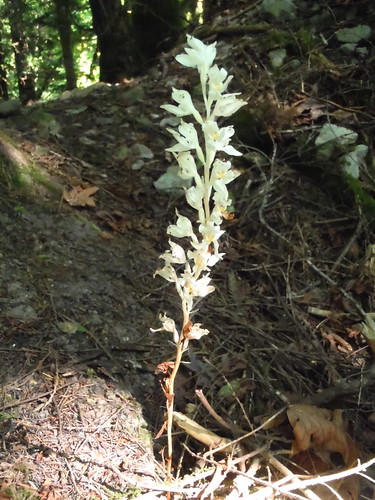grady
Well-Known Member
I found two phantom orchids this summer (Cephalanthera austiniae) on our property. Never saw them here before; hope they appear next year as well.


Here is the info from http://www.wanativeorchids.com/Cephalanthera austiniae/
Cephalanthera austiniae or Phantom Orchid is a very rare orchid. The Phantom Orchid is the only member of the genus Cephalanthera that is in North America and a mycoheterotrophic plant. The plant is terrestrial, mycoheterotrophic, leafless and completely white. Mycoheterotrophic plants are nonphotosynthetic parasites using fungal intermediaries to withdraw nutrients from other plants. Unlike holoparasitic plants, there is no direct contact of the parasite with its host plant. Instead, mycoheterotrophic plants are attached to hosts indirectly through fungal intermediates and are considered to be epiparasitic. The plant can stay dormant for years before sending out as stem. It may bloom once and then go into remission for up to 17 years. The flowers are white with a small yellow spot on the lip. This is the only North American orchid that is completely devoid of chlorophyll. Its food is drawn from the rotting humus of the forest floor, with the help of symbiotic fungi that “infects” the plant’s fibrous roots, sharing nutrients with it. The habitat is in the rich soils of dark coniferous or deciduous forests along mountain ranges. They only grow in forests with little to no undergrowth and limestone deposits. The distribution is in Washington, Oregon, Idaho, California and Southwestern British Columbia.
Threat to the species survival are also increasing through habitat loss. High levels of development and logging in key orchid habitats continue to place this species in peril, as well as mountain bike activity and native plant gathering.
Please do not pick the flowers, the low number of flowering stems the chance for seed development is very low.
Please do not try to transplant this plant, the success rate is nil. Just take a picture, it will last longer.
Height: 4 to 26 inches tall
Flower Size: ¾ to 1 ¼ inch wide
Blooms: June to September


Here is the info from http://www.wanativeorchids.com/Cephalanthera austiniae/
Cephalanthera austiniae or Phantom Orchid is a very rare orchid. The Phantom Orchid is the only member of the genus Cephalanthera that is in North America and a mycoheterotrophic plant. The plant is terrestrial, mycoheterotrophic, leafless and completely white. Mycoheterotrophic plants are nonphotosynthetic parasites using fungal intermediaries to withdraw nutrients from other plants. Unlike holoparasitic plants, there is no direct contact of the parasite with its host plant. Instead, mycoheterotrophic plants are attached to hosts indirectly through fungal intermediates and are considered to be epiparasitic. The plant can stay dormant for years before sending out as stem. It may bloom once and then go into remission for up to 17 years. The flowers are white with a small yellow spot on the lip. This is the only North American orchid that is completely devoid of chlorophyll. Its food is drawn from the rotting humus of the forest floor, with the help of symbiotic fungi that “infects” the plant’s fibrous roots, sharing nutrients with it. The habitat is in the rich soils of dark coniferous or deciduous forests along mountain ranges. They only grow in forests with little to no undergrowth and limestone deposits. The distribution is in Washington, Oregon, Idaho, California and Southwestern British Columbia.
Threat to the species survival are also increasing through habitat loss. High levels of development and logging in key orchid habitats continue to place this species in peril, as well as mountain bike activity and native plant gathering.
Please do not pick the flowers, the low number of flowering stems the chance for seed development is very low.
Please do not try to transplant this plant, the success rate is nil. Just take a picture, it will last longer.
Height: 4 to 26 inches tall
Flower Size: ¾ to 1 ¼ inch wide
Blooms: June to September














































